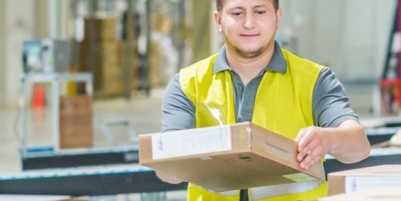-
ROSSLARE EUROPORT TARGETS HEALTH & SAFETY WITH CAMERA TELEMATICS PARTNERSHIP - 2 days ago
-
Landmark Study Reveals Wearable Robotics Significantly Boost Safety and Efficiency in Industrial Environments - July 24, 2024
-
Visku Tackle The Retail Seasonality Challenge One Pallet At A Time - July 22, 2024
-
KAMMAC AND BERGEN LOGISTICS STRENGTHEN FASHION & LIFESTYLE SERVICES IN THE UK - July 19, 2024
-
TENTBOX EXTENDS PARTNERSHIP WITH ARROWXL TO SUPPORT INCREASING DEMAND - July 17, 2024
-
The Perfume Shop improves customer journeys while driving profitability in partnership with Scurri - July 17, 2024
-
ZEROMISSION SECURES £2.3M ($3M) INVESTMENT TO ACCELERATE ELECTRIC FLEETS - July 16, 2024
-
BCMPA CELEBRATES SUCCESS OF 2024 CONFERENCE - July 15, 2024
-
Best of the Best: Jungheinrich Celebrates Triple International Award Win - July 12, 2024
-
GOPLASTICPALLETS.COM CALLS ON NEW CHANCELLOR RACHEL REEVES TO CONSIDER PLASTIC PACKAGING TAX REFORM - July 10, 2024
Mark Wharton, IBML’s business development manager looks at how firms in the transport and logistics industry can apply data capture solutions to streamline information sharing in the supply chain
It ranks as one of the Second World War’s most famous raids; a heroic RAF bombing by 133 aircrew that has passed into British wartime legend. 617 Squadron’s attack in 1943 on the great German dams of the Möhne, Sorpe and Eder – officially called Operation Chastise – aimed to cripple the industrial heartland of the Ruhr, end the war faster and bring the Allies back into the fight against the Nazis. Through the use of engineer Barnes Wallis’ brilliant yet almost fantastical ‘bouncing bomb’, it solved the intractable problem of how to get the explosive close enough to destroy the dams at a time when high level precision bombing was a technical impossibility.
The challenge of addressing seemingly intractable problems is also something the transport and logistics industry currently faces as customer demands have increased greatly. Individuals and businesses expect to receive goods faster, more flexibly and – in the case of consumers – either for free or at a low delivery cost. Online retailing has exploded, with volumes burgeoning especially since the start of the coronavirus pandemic.
On top of this, manufacturing is also becoming more and more customised with products like industrial equipment, planes, cars and consumer goods now being manufactured to the specifications of the end-customer – good for consumers obviously but harder work for the logistics industry to deliver. This particularly effects logistics service providers like 3PLs and 4PLs, with ‘digital fitness’ – as PwC states in a report – becoming a must for them.
One only needs to browse the press for a second to see how dependent everyone is on supply chains. The NHS struggled to get enough quantities of PPE at the start of Covid-19. Automotive chip shortages are now holding up car manufacturing and bringing into question the much vaunted benefits of Just in Time manufacturing designed to keep warehousing stocks low and costs down.
And the Ever Given debacle shows what happens when things go wrong; the megaship carrying 18,300 containers blocked the Suez Canal for a week holding up an estimated $9.6 billion of goods per day. It illustrates the complexity, importance and dependence we all have on the frictionless, reliable and transparent flow of goods.
Effective data capture and sharing is paramount to keep things on the move
Business process efficiency in the supply chain is therefore key to keep things on track. Data capture and information sharing self-evidently plays a crucial and fundamental role in trade covering everyone from retailer, manufacturer, logistics provider to port operator and end-user buyer.
The paperwork involved with this is immense: order forms, packing lists, shipper’s letter of instruction, certificates of origin, bills of lading, dock receipts, proof of delivery notices, proforma and commercial invoices, dangerous goods forms, passports and IDs for crew – the list goes on and on.
Managing this is complicated even more given the numerous different formats used by everyone in each step of the chain – everything from PDFs, Excel and Word documents, JPEGSs, emails, attachments, online forms and even faxes, of which surprisingly, billions are still sent every day. Worryingly though, it is estimated that 80% of logistics firms still use paper forms and over half of the data contained is entered manually into IT systems.
Furthermore, analyst firm Gartner say that while 72% of organisations in the supply chain see technology as a source of competitive advantage, the majority – 53% – continue to manage supply chain technology vertically around functional silos and not horizontally and holistically across functional domains.
Working in a data silo is a recipe for major inefficiency and, in a world where ‘digital fitness’ is paramount, a huge failing. Simply put, the documentation and the data contained which goes along with all goods needs to flow as smoothly as the physical items themselves.
Avoiding data silos isn’t as hard as you think
It’s not all doom and gloom however. Scanning paper, automating data capture and improving integration is a practical and proven way to solve this. It makes information flow faster, enhances accuracy, boosts reliability so that the chance for goods to be held up at the point of origin or delivery because of paperwork issues is removed.
A variety of powerful tried and tested capture applications are available. Modern solutions – both on-premise, mobile or cloud native SaaS systems – can handle information from practically any source once digitised or cater for information ‘born’ electronic. In the jargon, this covers everything from structured, semi-structured and unstructured data.
Capture applications automatically ‘read’ key fields in documents like customer name, address, account number, order number, quantity along with QR and barcodes and even normal handwriting. Data is ingested, classified and metadata intelligently extracted using machine learning and advanced tools like Artificial Intelligence to then workflow this information to any number of ERP, CRM, BPM, ECM or corporate systems. These capture applications can ‘learn’ based on content handled and historical tagging to make this a super-fast, accurate and reliable process, eliminating the need for human intervention.
Other technologies such as Robotic Process Automation [RPA] can be applied to the capture process to automate mundane, repetitive and error prone tasks involved with manual data entry. RPA also aids the integration of legacy business systems – and getting data into them – without the need for complex APIs to be written.
The benefits of automated data capture are clear
Automating the data capture process is a sure-fire way to gain efficiencies and return on investment:
- It enables more accurate communication between transport and logistics operators and their customers;
- There’s less room for mistakes when capturing, ingesting and populating line of business systems as you remove the ‘human’ component. If you manually key in data, not only does this take time and is subject to errors, but because of the staff overhead, it’s often badly done resulting in partners in the supply chain not getting the information they actually need.
- There’s no need to employ staff to carry out dull data entry jobs, with existing employees able to be redeployed to focus on more useful and productive work;
- New SaaS cloud-native capture systems enable firms in the supply chain to be agile and scale up and down as demand and volumes dictate – say during the busy Christmas period – without enduring substantial capital expenditure or complex IT implementation challenges;
- It’s greener and more ec0-friendly as excess paper is removed from the sales cycle and delivery process;
- Digitising and managing content in all its forms facilitates downstream processes much better like analytics to aid better decision making in the future.
The pressure to be efficient in the transport and logistics industry is high. Cutting edge technology here is evolving fast, too: robotics and warehouse automation, 3D printing, drones, human exoskeletons to boost strength and ensure safety, autonomous vehicles and so on.
But the low hanging fruit of scanning, automating and streamlining business processes and the documentation associated with the supply chain should not be forgotten especially as the pressure to be efficient, lean and effective is on to maximise margins and ultimately profit.
Get it right, and like 617 Squadron 78 years ago, it means today’s transport and logistics firms can hopefully keep bouncing and bouncing to success in these ever changing times.

































